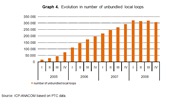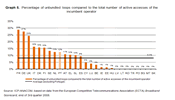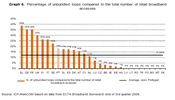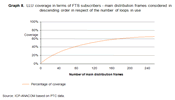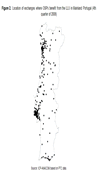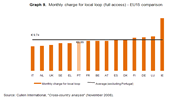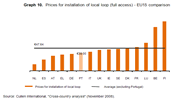The local loop unbundling offer (LLU), which has allowed other service providers (OSP) to supply end customers with their narrowband and/or broadband services, is marked, as regards the evolution of the number of unbundled loops, by a slight decrease over the course of 2008, while in annual terms an increase has been registered of 5 percent: 305,244 unbundled loops at the end of 2008 compared to 291,175 unbundled loops at the end of the previous year (Graph 4).
Graph 4. Evolution in number of unbundled local loops
Despite the developments described above, at the end of the third quarter of 2008, it was reported that the penetration of unbundled loops in Portugal compared to the total number of active accesses of the incumbent operator was above the average of the surveyed countries (excluding Portugal) - see Graph 5.
Graph 5. Percentage of unbundled loops compared to the total number of active accesses of the incumbent operator
Analysing the penetration of unbundled loops in terms of the total number of retail broadband accesses, it was concluded that Portugal is well ranked among the set of European countries, with a value of 18 percent, which is higher than the average found in the countries surveyed (Graph 6).
Graph 6. Percentage of unbundled loops compared to the total number of retail broadband accesses
With respect to the presence of OSPs in the exchanges of PTC, it was found that during 2008 the number of exchanges with co-installed operators continued to increase, rising from 221 at the end of 2007 to 258 at the end of 2008 (Graph 7).
Graph 7. Number of exchanges with co-installed operators
Along with the increased number of exchanges with co-installed operators, there was an increase in the coverage of LLU-based retail offers from new operators. At the end of 2008 coverage was already over 65 percent of the total number of subscribers to the telephone service at a fixed location (FTS) of PTC, as demonstrated by Graph 8.
It should be made clear that, in light of the distribution of accesses among the various PTC exchanges (there are exchanges with tens of thousands of accesses and others with only a few dozen accesses), Graph 8 shows a concave curve - the marginal contribution of each exchange to the increase in overall LLU coverage will be increasingly less.
Graph 8. LLU coverage in terms of FTS subscribers - main distribution frames considered in descending order in respect of the number of loops in use
This increase in potential coverage not only reflects an increase in the number of loops which can be unbundled but also a broadening of geographical areas with access to the new offers. Figure 2 shows the location of exchanges where there were co-installed OSPs as at the end of 2008 and from which LLU-based retail offers could be offered.
Figure 2. Location of exchanges where OSPs benefit from the LLU in Mainland Portugal (4th quarter of 2008)
During 2008, ICP-ANACOM did not take a decision on any changes to prices applicable to the RUO. Nevertheless, existing prices were monitored and analyzed, especially in comparison to prices in other European countries.
International comparisons of prices indicate that prices in Portugal in 2008 continued, in any case, to compare well with practices at Community level (EU15), showing lower values than the average, as can be seen in the graphs below:
Graph 9. Monthly charge for local loop (full access) - EU15 comparison
Graph 10. Prices for installation of local loop (full access) - EU15 comparison
Following the limited consultation, launched in 2007, to conduct an audit of the most relevant indicators of quality of service in respect of access to the local loop provided by PTC, for the period covering the first half of 2007, on 23 January 2008, this service was contracted from the company PricewaterhouseCoopers - Assessoria de Gestão, Lda. This audit took place during 2008 with the work concluded in 2009 and also covered the service of leased circuits.
2008 was also marked by requests for ICP-ANACOM’s intervention, pursuant to article 10 of the LEC with respect to the resolution of three disputes regarding: (i) the non-payment of bills for power consumption in the context of the RUO (a final decision was adopted on 16 April 2008, whereby the application was denied due to the time elapsed); (ii) the request by Sonaecom for the payment of compensation for failures to comply with the levels of quality of service established in the RUO in response to requests for verification of eligibility in 2006 (the final decision was adopted on 4 June 2008, whereunder the request was denied); (iii) the payment of compensation for failure to comply in 2006 with the levels of quality of service and time limits applicable to the restoration of service (repair of faults), established in RUO 1 (the DD was adopted on 30 April 2008, with the final decision adopted in 2009).
1 And in the leased lines reference offer (LLRO).

